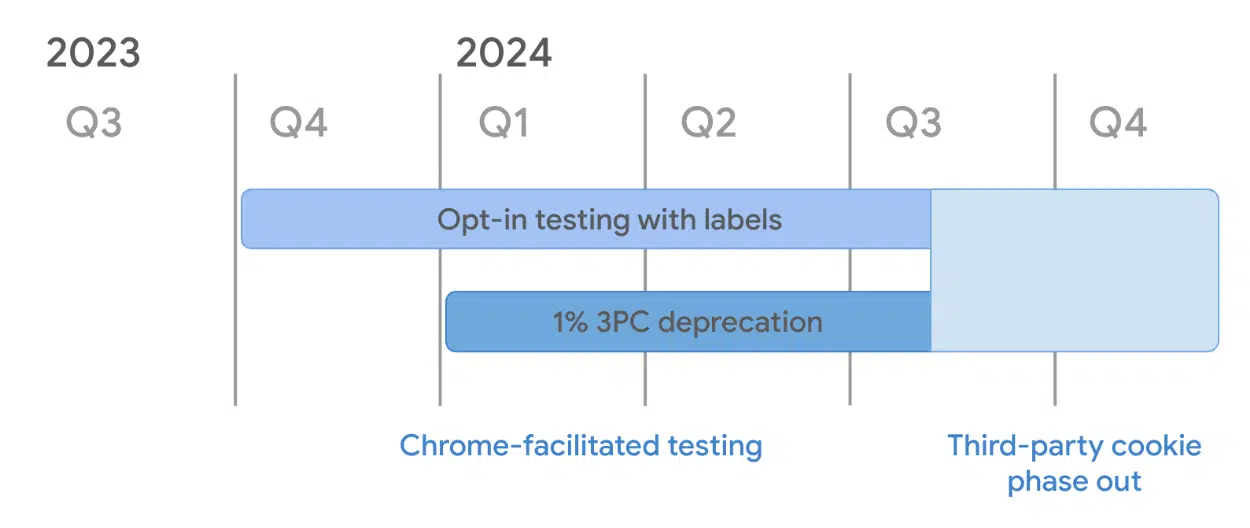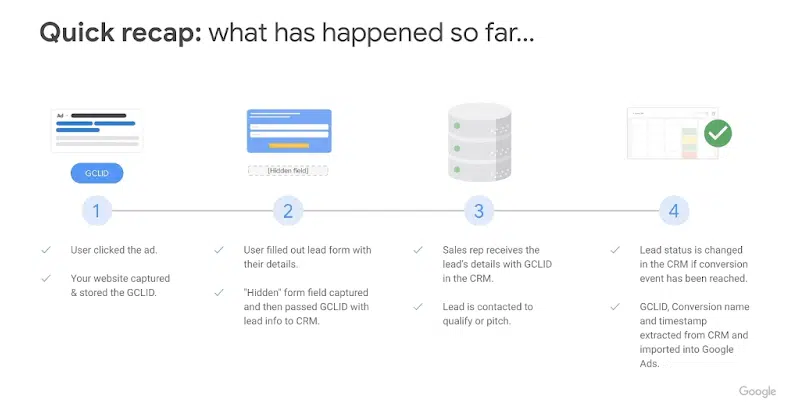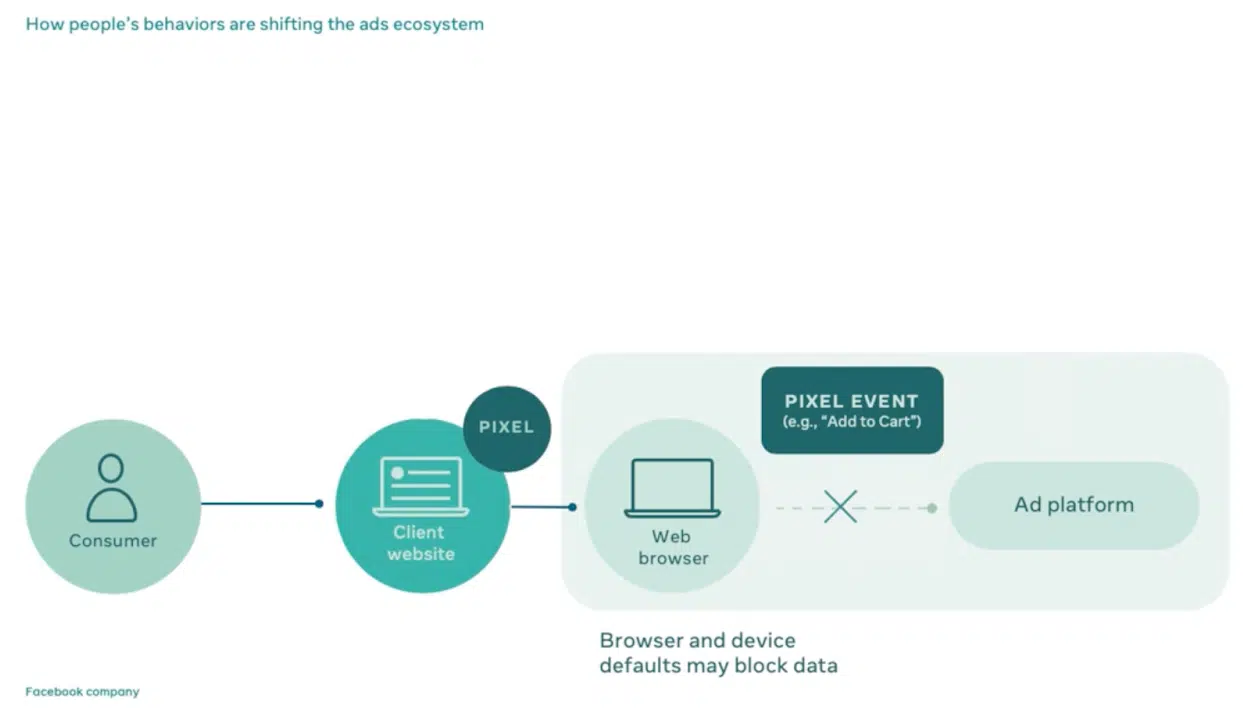[ad_1]
The big cookie crumble of 2024 officially began in January with Google’s initial roll-out of Tracking Protection for Chrome users.
Any PPC marketer caught off-guard by this either haven’t paid attention to the signals for several years or haven’t corralled the necessary parties to create a cohesive strategy in response – or both.
As an agency marketer, I’ve been in the position to help dozens of brands formulate an approach to life after third-party cookies.
Whether you’re scrambling for an overall strategy or need guidance on the high-leverage initiatives to prioritize, I can say with confidence that you’ll be well ahead of the curve if you tackle these three projects right away:
Here’s why each project is vital in a world without third-party cookies.
1. Website design: Audit your use of third-party cookies
Google has provided a handy reference point (including the images below) for marketers to get their bearings on the cookie phaseout.


For this step, we’ll focus on the second phase of that page: Auditing your use of cookies.


Google’s literature is a helpful reminder of a couple of angles to the third-party cookie phaseout that go beyond tracking:
- Usability issues lurk everywhere if you don’t get a handle on your site’s embedded content and widgets. (Check that “add to calendar” function!)
- Even if you have first-party cookies set up, consistent usage of proper code is important for smoothing out how your site behaves across browsers.
Yes, you need to focus on improving targeting and analytics without cookies, but don’t put the cart before the horse: a working website.
Dig deeper: PPC outlook: How advertisers can stay ahead in 2024
Get the daily newsletter search marketers rely on.
2. In-platform data integration
OK, now about that tracking and reporting. Major ad platforms have given advertisers ways to improve in-platform reporting and help bidding and targeting algorithms find high-quality users.
Google: Integrate offline conversion tracking
Whether you’re relying on digital ad campaigns to help drive B2C offline conversions (think: car dealerships) or driving leads for B2B, it’s critical to your understanding of campaign performance – and your future performance – to integrate offline conversion tracking (OCT), or offline conversion data, into your Google campaigns.


Reporting-wise, adding OCT brings a critical level of nuance to the value your campaigns are driving.
Instead of citing a mass of new leads and exchanging high-fives with your colleagues, integrate your CRM data to understand how many of those leads made it through the funnel to stages like MQL, SQL, SAL, and opportunity.
The benefits are huge. You will:
- Find areas to cut without compromising your pipeline.
- Identify sources of high-quality leads where you should increase investment.
Campaigns that simply set bidding for leads without using OCT to teach the targeting algorithms how to find quality leads are giving Google a license to go after the easiest possible targets.
This will result in a lot of junk pouring into your CRM. Your CPL may drop, but your CPQL (cost per qualified lead) will likely suffer.
Dig deeper: 5 best practices for tracking offline conversions in Google Ads
Facebook: Incorporate Conversions API
Before Google began its cookie phaseout, Apple’s iOS 14 kicked a leg out from under Facebook’s conversion reporting, led advertisers to leave or minimize the platform in droves, and tanked Facebook stock prices.
In response, Facebook leaned into its conversions API (CAPI) product, which requires dev work but moves conversion tracking to your website’s server.
It doesn’t rely on cookie tracking and effectively gives you more accurate conversion tracking in an iOS 14 and post-cookie world.


This has much the same benefits as Google’s OCT integration. You can:
- Better understand your campaign performance. (This goes for all verticals, including ecommerce).
- Use that data to train the bidding algorithm to find more valuable users.
LinkedIn: Incorporate CAPI
B2B marketers know the challenges of a long sales cycle with multiple conversion events and many stages of a lead.
LinkedIn’s CAPI, which follows the same principles as Facebook’s, is crucial for understanding advertising’s impact on the pipeline.
As far as using offline data to train LinkedIn’s algorithm, LinkedIn’s algorithm isn’t quite as refined as Facebook’s (yet) in finding the right users, but incorporating OCT is a good practice that should bear fruit.
Geo lift testing and media mix modeling (MMM) are two very different methods to tackle the same challenge: measuring incrementality – or the true value of your paid initiatives irrespective of click-based tracking limitations.
These are practices we’ve been preaching long before the cookie phaseout, but introducing more tracking limitations makes them even more important for seeing an accurate picture of your campaign performance.
Lift testing, which divides audiences into test groups and holdout (or control) groups to show causality on ad results, can take the form of geo holdouts, PSA testing, etc.
Media mix modeling is a more technical approach that usually requires third-party software and pulls from a large amount of data (we recommend at least two years’ worth) to determine performance correlations.
The pros and cons of each approach break down as follows:
Whatever their relative pros and cons, the main pro of the two big options for incrementality measurement is the same: you’ll know the value of your ad campaigns, with or without cookies.
Either way, every savvy search marketer should double down on dedicating time and budget to measuring the true value of initiatives like:
- Retargeting (where users might have converted anyway).
- Google brand search (branded keywords, often over-valued).
- Google non-brand search (more generic keywords, often undervalued).
Learnings from such measurement exercises are likely to help refine your media mix and ultimately produce more revenue.
Over the years, we’ve seen many marketers develop a bias for direct-response marketing that stems from cookie-based measurement.
That bias has typically ignored factors like the halo effect and devalues upper-funnel KPIs like impressions and reach.
Ultimately, if cookie extinction forces us to look at the full picture instead of leaning only on down-funnel metrics and last-touch conversions, we’ll be better.
Dig deeper: Efficiency vs. volume in PPC: 4 tips to strike a balance in incremental conversions
Set up your marketing for success even without third-party cookies
If you don’t have a background in analytics and haven’t considered the data picture deeply, these initiatives might spark some angst.
The good news is that they are the way forward, and tackling them now will help you future-proof your marketing as privacy regulations develop.
Couple that with robust partner systems and a growing pool of solution providers, and it won’t be that hard to clear a way forward through the cookie crumbs. But it is time to get moving.
Opinions expressed in this article are those of the guest author and not necessarily Search Engine Land. Staff authors are listed here.
[ad_2]





